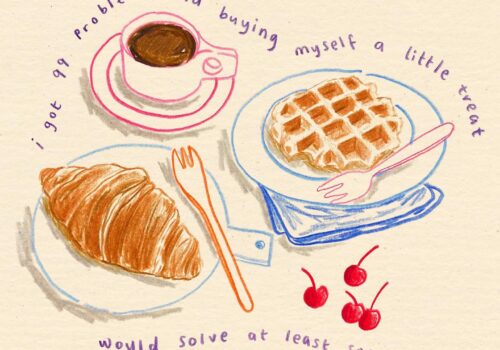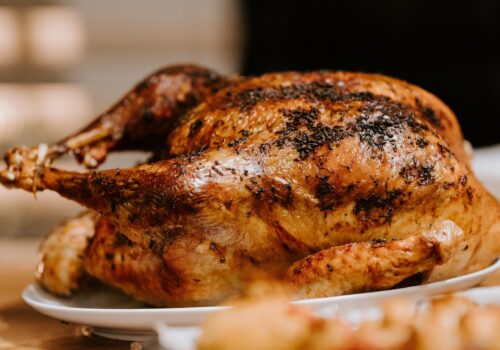Lemon Girl, Strawberry Girl, Baked-Beans Girl: Why Food Girls are Driving Micro-Trends on TikTok
Words: Shamim de Brún
Images: Via Glamour
The “[insert descriptor]-girl” framework cemented itself as a genre in 2019 thanks to the song-cum-meme “Hot Girl Summer.” But why, all of a sudden, are they all food girls? These days, creator after creator churns out video after video of what makes a person a: tomato girl, strawberry girl, baked beans girl, hard-boiled egg girl, mango girl, vanilla girl, coconut girl, olive girl, potato girl, etc. The list goes on. The search “food-inspired” on TikTok has 666 million views and counting. So we rolled up our sleeves and waded in to find out what’s actually happening
While food-inspired styles aren’t a new thing. (Aesthetic moodboards featuring food defined much of 2010s Tumblr). They’re more relevant than ever today. These micro trends and aesthetics have been enthusiastically embraced by everyone from TikTok-ers to brands and celebrities such as Blake Lively and Sophie Turner, according to the Zoe Report. Their rise parallels neatly with the girl dinner phenomenon, which dominated much of the summer and snowballed into a blizzard of think pieces. So it’s likely food has been on everyone’s mind thanks to its ubiquity.
A Tweet drew the attention of the world at large to food-inspired TikTok fashion aesthetics. “POV: a tomato girl and a boiled egg girl become friends, and they call their clique the shakshukas,” wrote Howard in a Tweet.
This summer, the media has dedicated an acre of column inches to pieces explaining what these aesthetics are and how to adopt them. InStyle wrote, “Tomato Girl Summer Explained, Plus 3 Foodie-Forward Aesthetic Alternatives.” “This Summer I’m Embracing Lemon Girl Style,” wrote Glamour. It feels like influencers such as Hailey Bieber simply pick a food and let their imaginations run wild, creating images of clothes, make-up, sights, activities and music that are vaguely related to the ‘vibes’ suggested by that food.
Everything about this onslaught of food girls is intentionally vague enough that the aesthetics can sometimes seem interchangeable, differing only slightly (as with strawberry girl and tomato girl). You could easily mistake one for the other if you weren’t uber-versed in the minute differences in the tones of strawberry and tomato red.
None of that matters in the marshes of TikTok, however, because each and every food-girl variation hashtag garners views. Millions and millions of views. Lemon Girl is sitting pretty at 11.5 million. Strawberry Girl hits hard at 63.9 views and Cherry Girl is resting on 36.5million.
There are enough foods that everyone can surely fall into some subgenre so all possible bases are covered. One might not be as pink and skincare obsessed as the strawberry girl, but you could be a bean girl. If you’re not sure which you fall into, then maybe try this handy BuzzFeed quiz, where they’ll sort you quicker than Hogwarts.
They seem to me to be mostly permutations of ‘that girl’. “That girl” is a wellness archetype that rose to prominence on Instagram and TikTok. It’s a trend that encourages women to be “that girl,” the one who wakes up early, practices yoga, journals, drinks green juice, wears athleisure and only minimal makeup, but looks after her skin like it’s a part-time job. Be ‘That Girl’ who continuously self-optimises and improves their life.
That girl in yellow is Lemon Girl, that girl in a muted green is Olive Girl, etc. According to their TikTok collages, they are all effortlessly elegant and enviably chic. Most seem to be Pinterest-level slim as well. They all have 12-step Korean skincare routines and wear no more than tinted moisturiser and a swipe of mascara to dinner. They’re aspirational. They journal, read, and take wellness seriously. They’re almost Goopy but less woo-woo.
They have their opposites, too. It’s likely Rat Girl was born out of a rebellion against this trend. The same with the baked beans girl and the hard-boiled egg girl. They are the “chaotic on-the-go” food girls. According to Insider, a baked beans girl ‘is at once a fiend for chaos (see: Crocs filled with, yes, baked beans) and a skincare devotee’.
I think the original food girl was the garlic girl. The garlic girl was born differently, though. It was born of a true love for adding much more garlic than the recipe calls for. Garlic girls were a community that needed to find a place, and TikTok was that place. Pickle girls are similar. These were subcultures of women who really loved a food. So much so that it became an aesthetic. There was merch, videos, explainers, articles. Now, it seems to have flipped. The aesthetic comes first, and the food acts as a shorthand for the ‘vibe’.
The tomato-girl leap seems to be that tomatoes are red; they make you think of Italy in the summer and the sauce on your Neapolitan pizza or the ragu that a doting Sicilian ‘noni’ would make for her grandkids. So the tomato girl wears red, loves traditions, makes fresh pasta at home and holidays in southern Italy. With every American under the sun in Italy this summer, it’s easy to see how she came to dominate the food-girls this year.
Food has become one of the most popular ways to label these micro trends for many reasons. Food is sensory, visual, and cultural. Many foods have aesthetics hardwired into our brains from our collective exposure to them. Fresh tomatoes evoke an Italian aura because of things like Dolmio ads and Italian restaurants.
Strawberries will always conjure up youthful, sunny summer evenings. Make-up has been making lip balms strawberry flavoured since time immemorial because of this.
This makes food not only efficient but ‘optimal for eclectic moodboarding’ and convenient for ‘playfully ambiguous ad marketing’ according to Bon Appetit. Because ultimately, that’s what it is. These girls are trying to sell us stuff. Sell us on their lifestyle, their make-up, their socks. Hailey Bieber is the clearest example of this. She initiated and projected the strawberry girl thing so long before she dropped her strawberry girl line of products that it’s hard to be sure which came first. My money is on the products.
The thrill seems to be similar to horoscopes. There is a playful element of self-recognition. You can almost hear people saying ‘that is so me’ as they watch an Onion Girl video before they go looking for a similar dress on Depop. People love to see themselves reflected in art. They always have. That’s why representation matters. Why so many girls and women see themselves reflected in these representations is probably because they, and people like them, are creating them.
The one throughline is that all these micro trends are “girls”. They are created by and marketed towards young women and girls. Their aesthetics are typically built off reinventions of cultural classics and things that are quintessential parts of girlhood. Things like ruffled socks and gingham. Things that were once looked down upon for being ‘girly’ with ‘girly’ being a pejorative.
For a long time, aesthetics in all their forms were decided by men and women just had to adapt. Gatekeepers in the forms of designers, ad men, salesmen and journalists would decide what was going to be the “in” thing of the season and they would put their energies into promoting it. With the democratisation of the internet, the girls can do it for themselves. They create and latch onto their own ‘in’ things. Then, turn them into products to sell to us, be it the attention economy or in the form of real-life products. The most obvious example of this being Hailey Bieber’s entire line of Strawberry Girl products.
Ultimately, the entire internet is fueled by people selling us stuff. So this shouldn’t come as a surprise. The more microtrends that proliferate, the more ephemeral they become. Overall, food girls are a harmless, fun trend. Maybe it’s a touch unconventional, but it’s a fun way for people to talk about food, fashion, artistry and culture quickly in video form.
Elsewhere on CHAR: Why Rat Girls Are All About Rotisserie Chicken



